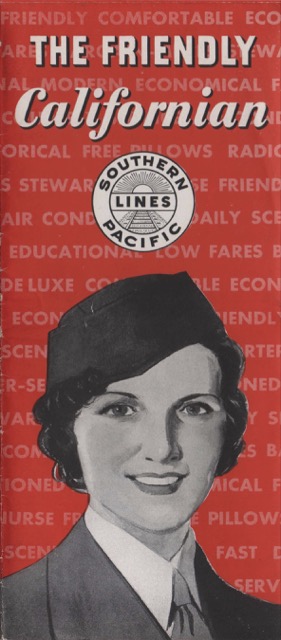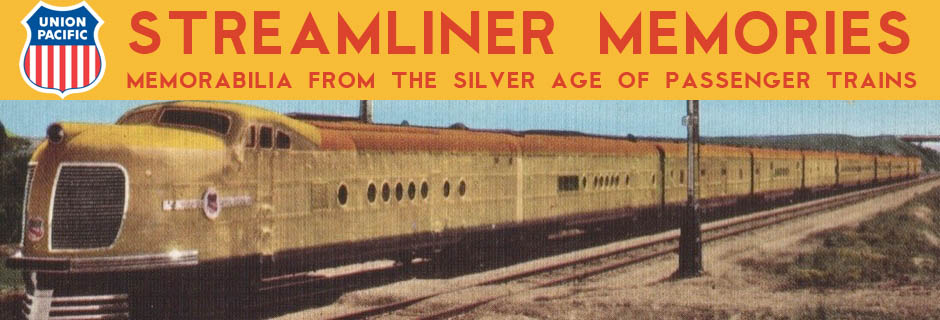Inaugurated in 1937, the Rock Island-Southern Pacific Californian was an attempt to compete with the Union Pacific Challenger in the Chicago-Los Angeles market. In other words, it was a low-cost train with tourist sleepers rather than Pullmans and low-cost meals in the dining car: breakfast for 25 cents, lunch for 30, and dinner for 35 cents. A dining car photo in this 1938 brochure shows Prairie-Mountain Wildflower china.
 Click image to download a 4.9-MB PDF of this brochure.
Click image to download a 4.9-MB PDF of this brochure.
Yet the train did have some amenities designed to attract non-business travelers (since business travelers would probably take the Golden State Limited), including an on-board nurse-stewardess and a coach designated for women and children only. While this brochure advertises new streamlined coaches, the tourist sleepers look primitive, with no dividers between sections. At least the train had a full-length lounge car for sleeping-car passengers only. The Californian disappeared from the timetable in the late 1940s.

Tourist sleepers were an interesting beast. They were the successors to the emigrant sleepers of the late 19th and early 20th centuries. The long haul railroads, primarily in the west, were trying to win more customers as well as break the stranglehold Pullman had on the sleeping car business. The Santa Fe was the first railroad to introduce the modern concept of the tourist sleep. It was aimed at families, and the appeal was everyone traveling together at a relatively low fare, as well as a real bed at night. Some of the Santa Fe cars even had small kitchen, to allow families to prepare meals. There are many stories of how the Chicago to Los Angeles train became a three day pot luck.
Most tourist sleepers were surplus older Pullman 16 section sleepers that the railroads purchased from Pullman. Pullman didn’t see this as a threat to their business since they assumed the railroads would continue to run them as 16 section open sleepers, something travelers hated, since there was very little privacy, and the berths were shorter and narrower than those in the newer 12 and 10 section sleepers. The western railroads, however, had different ideas.
The SP tourist sleepers had only been in service for about six months when the brochure was printed. As more sleepers became available, the older tourist sleepers were rebuilt to include things like partitions, larger berths, separate heating and A/C controls, better reading lamps, and fans. On the outside, all the roof appurtenances were hidden in a new arch roof, windows were now sealed dual pane glass, and new swing motion trucks were substituted for the older six wheel leaf spring trucks. For all intents and purposes, they looked like the new “streamlined” sleepers.
The Pullman company had a fit when they realized what the railroads were up to. They refused to allow Pullmans to be carried in the same train as tourist sleepers. That’s why the Californian proudly advertised itself as an all tourist sleeper train. In reality, the SP had little choice if it wanted to offer this alternative.
As the railroads built or converted more cars to tourist sleepers, Pullman’s business began to be negatively affected. They decided if you can’t beat ’em, join ’em, and started building and staffing tourist sleepers. The staffing part is what the railroads really lacked, since they had no experience training porters, nor did conductors normally have to deal with sleeping car passengers. Pullman did, and, especially on the SP, that sealed the deal to have Pullman operated, rather than railroad operated, tourist sleepers.
The Santa Fe and Milwaukee Road resisted Pullman and continued to build and convert their own versions of the tourist sleeper. The MILW, in particular, rebuilt about 100 older open section sleepers into single room accommodations with no upper berth and a folding door for privacy, useable at all hours. This led to the design of what became the roomette, a rousing success for the Budd Company. Unfortunately, it all came about a decade too late, as better highways and roadside accommodations plus the rise of the airlines killed off the long distance passenger train. Budd’s last permutation of the tourist sleeper, the Slumbercoach, was never the success of the roomette. There’s an excellent article about the Slumbercoach at http://www.srmduluth.org/Exhibits/SlumberCoaches.pdf.
Jim